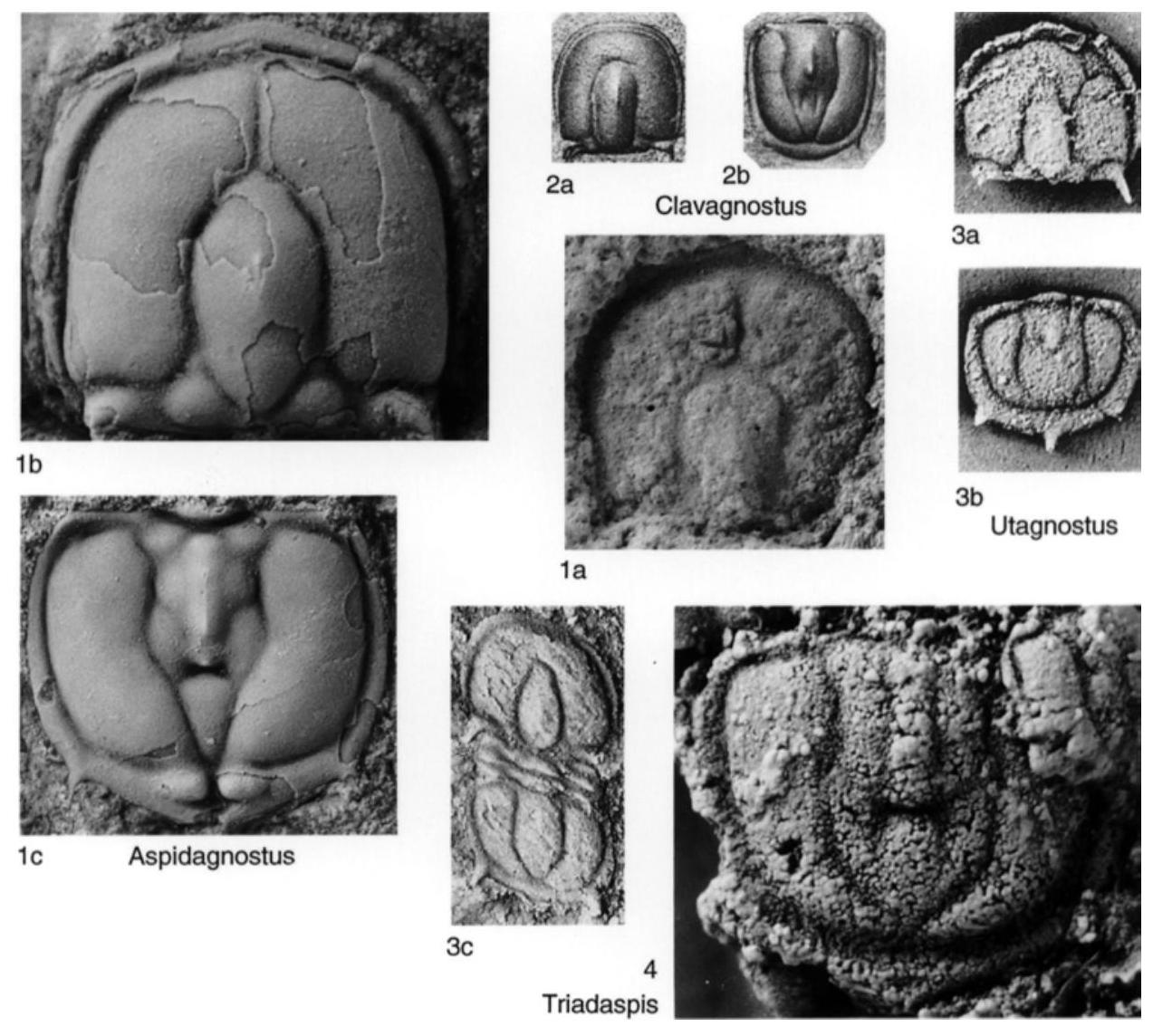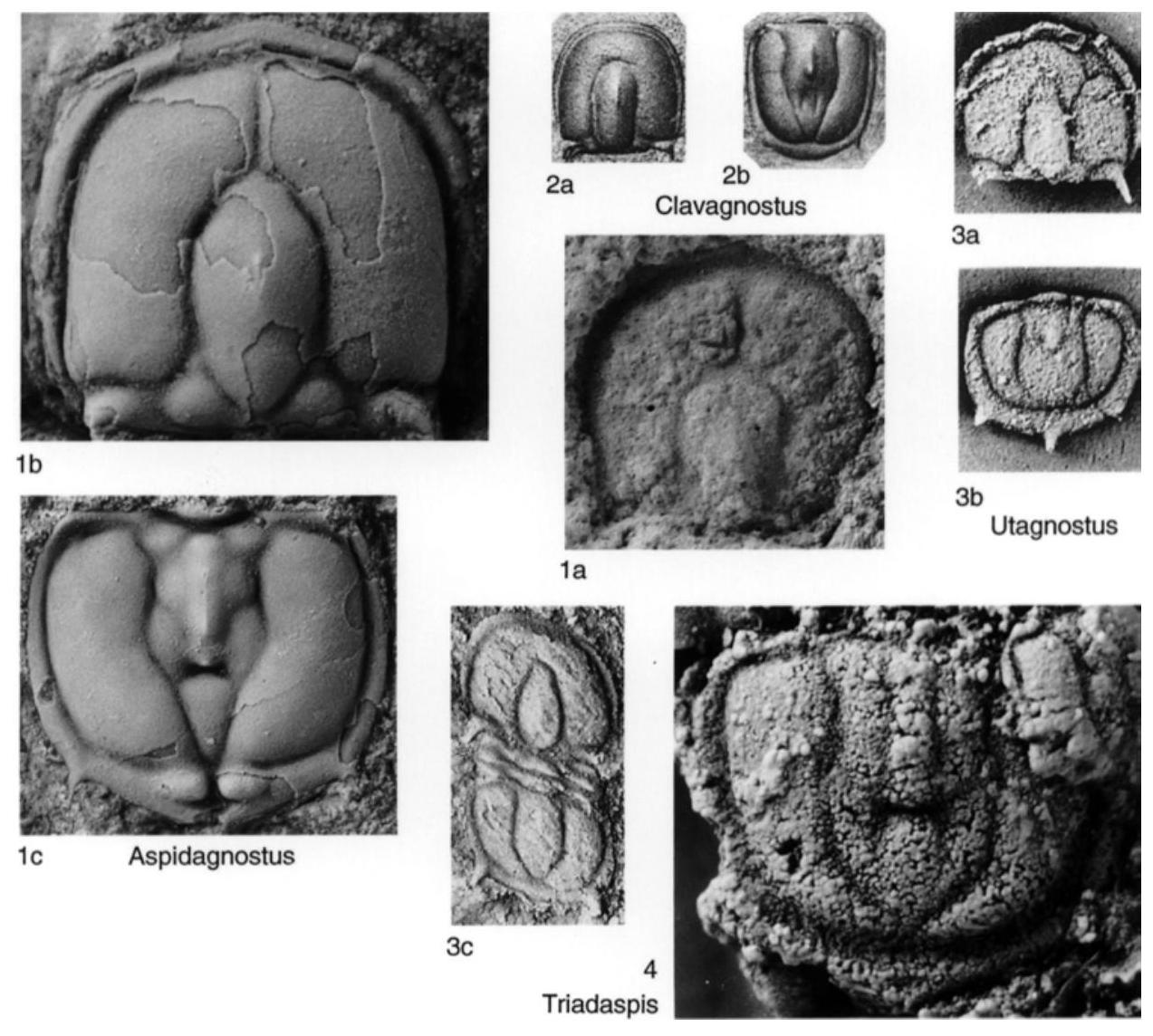Welcome to the Treatise on Invertebrate Paleontology!
Please enter a genera name to retrieve more information.

Utagnostus
Classification
Phylum:
Arthropoda
Class:
Trilobita
Order:
Agnostida
Superfamily:
Agnostoidea
Family:
Clavagnostidae
Subfamily:
Clavagnostidae - Uncertain Subfamily
Formal Genus Name and Reference:
Utagnostus ROBISON, 1964, p. 533
Type Species:
U. trispinulus, OD, holotype (ROBISON, 1964, pl. 82, fig. 25), 141226, USNM, Washington, D.C.
Images
(Click to enlarge in a new window)
Fig. 235,3a,b. *U. trispinulus, upper Middle Cambrian (Bolaspidella contracta Subzone), USA (House Range, western Utah); a, paratype, cephalon, USNM 141223, ×9; b, holotype, pygidium, USNM 141226, × 10 (Robison, 1964, pl. 82, fig. 21, 25).——Fig. 235,3c. U. neglectus, upper Middle Cambrian (Boomerangian, Lejopyge laevigata Zone), Australia (Christmas Hills, northwestern Tasmania); holotype, exoskeleton, UTGD 86844i, × 11 (Jago, 1976, pl. 23, fig. 13).
Synonyms
Geographic Distribution
USA (Utah), upper P. punctuosus to lower L. laevigata Zones; Australia (New South Wales), ?P. punctuosus Zone.
Age Range
Beginning Stage in Treatise Usage:
upper Middle Cambrian
Beginning International Stage:
Drumian
Fraction Up In Beginning Stage:
0
Beginning Date:
504.5
Ending Stage in Treatise Usage:
lower Upper Cambrian
Ending International Stage:
Jiangshanian
Fraction Up In Ending Stage:
25
Ending Date:
493.4
Description
Small, en grande tenue, nonscrobiculate, with nondeliquiate border furrows, narrow cephalic and broad pygidial border, cephalic spines well developed, median preglabellar furrow absent. Glabella with small, low, semiovate anterior lobe, F3 weakly impressed, nearly straight, glabellar node about level with F2 furrows, basal lobes very small, simple. Pygidium trispinose, F1 effaced, F2 clearly impressed, strongly deflected by elongate axial node, posterior lobe semiovate, broadly rounded posteriorly, of low convexity.
References
Robison, R. A. 1964. Late Middle Cambrian faunas from western Utah. Journal of Paleontology 38:510566, fig. 1-4, pl. 79-92.
Museum or Author Information
Classification
Phylum:
Arthropoda
Class:
Trilobita
Order:
Agnostida
Superfamily:
Agnostoidea
Family:
Clavagnostidae
Subfamily:
Clavagnostidae - Uncertain Subfamily
Formal Genus Name and Reference:
Utagnostus ROBISON, 1964, p. 533
Type Species:
U. trispinulus, OD, holotype (ROBISON, 1964, pl. 82, fig. 25), 141226, USNM, Washington, D.C.
Images
(Click to enlarge in a new window)
Fig. 235,3a,b. *U. trispinulus, upper Middle Cambrian (Bolaspidella contracta Subzone), USA (House Range, western Utah); a, paratype, cephalon, USNM 141223, ×9; b, holotype, pygidium, USNM 141226, × 10 (Robison, 1964, pl. 82, fig. 21, 25).——Fig. 235,3c. U. neglectus, upper Middle Cambrian (Boomerangian, Lejopyge laevigata Zone), Australia (Christmas Hills, northwestern Tasmania); holotype, exoskeleton, UTGD 86844i, × 11 (Jago, 1976, pl. 23, fig. 13).
Synonyms
Geographic Distribution
USA (Utah), upper P. punctuosus to lower L. laevigata Zones; Australia (New South Wales), ?P. punctuosus Zone.
Age Range
Beginning Stage in Treatise Usage:
upper Middle Cambrian
Beginning International Stage:
Drumian
Fraction Up In Beginning Stage:
0
Beginning Date:
504.5
Ending Stage in Treatise Usage:
lower Upper Cambrian
Ending International Stage:
Jiangshanian
Fraction Up In Ending Stage:
25
Ending Date:
493.4
Description
Small, en grande tenue, nonscrobiculate, with nondeliquiate border furrows, narrow cephalic and broad pygidial border, cephalic spines well developed, median preglabellar furrow absent. Glabella with small, low, semiovate anterior lobe, F3 weakly impressed, nearly straight, glabellar node about level with F2 furrows, basal lobes very small, simple. Pygidium trispinose, F1 effaced, F2 clearly impressed, strongly deflected by elongate axial node, posterior lobe semiovate, broadly rounded posteriorly, of low convexity.
References
Robison, R. A. 1964. Late Middle Cambrian faunas from western Utah. Journal of Paleontology 38:510566, fig. 1-4, pl. 79-92.

